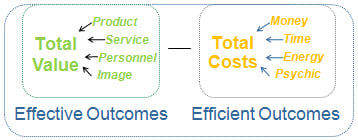 Customer experience value is seldom quantified from the customer’s viewpoint. We explore it through customer journey mapping, customer advisory boards, surveys, user experience testing, and so forth. Even so, we still may not be sizing it up from their perspective.
Customer experience value is seldom quantified from the customer’s viewpoint. We explore it through customer journey mapping, customer advisory boards, surveys, user experience testing, and so forth. Even so, we still may not be sizing it up from their perspective.
Customer experience value creation occurs when you empower customers to achieve their goals with greater satisfaction in a win-win approach.
Customer experience value creation is creating mutual value for your whole customer base in any part of the end-to-end customer experience, across the full customer life cycle, spanning customers’ entire dealings with your organization, products, services, channels and affiliations. It’s value as seen by the customer, relative to their alternatives, relative to all the costs they endure, and relative to the outcomes they’re pursuing.
Value is one of those ambiguous words, yet it’s an extremely important word. Value can mean price, benefits received for the price paid, deep-discount price, benefits relative to alternatives, high importance, rare and precious, earnings per share, wealth-building, and more.
We tend to think of how valuable it is to formally manage customer experience. We like to see studies about the superior value received by leaders versus laggards in customer experience management. We dabble with calculating customer lifetime value (cumulative profitability of a customer). We accept for granted that “businesses exist to create value for shareholders”.
To maximize our performance toward shareholder value, it’s essential to focus on the customer’s view of customer experience value. Why is customer experience value a precursor to shareholder value? Customers hold the purse strings. Based on their perception of overall value: they buy, rebuy, spread positive word-of-mouth, expand your share of their budget, and give you useful inputs to managing your business for greater success all-around. That’s the pipeline for shareholder value. Focusing on customer experience value puts the horse before the cart: the cart is shareholder value and the horse is customer spending spurred by the value they experience.
Customer experience value is the degree of upside compared to the degree of downside for a customer to do business with an organization.
Here are 4 prerequisites to creating customer experience value:
1st Prerequisite: Value Your Customer Value Quotient
Customer experience value quotient is a helpful way of thinking about customer experience value. It’s a ratio, where the numerator includes product and service value, as well as image and personal value. We may often overlook or be unaware of some of the cost dimensions in the denominator: money . . . plus time, energy and psychic costs (i.e. worry, inconvenience, frustration, and ripple effects to the buyer’s relationships with others). Customer experience value quotient opens your thinking for innovations on both sides of the ratio.

Customer experience value creation can be as simple as an airline borrowing the concept of “departure gate change text messaging” and applying it to “baggage text messaging” so travelers realize as soon as they turn on their phones upon landing that their bags were re-routed on a different flight, without having to wait at the carousel, then wait in the claims line, etc. Customer experience value creation is anything that innovates a process, policy, product, service, business model, information, and so on, to improve the customer experience value quotient.
2nd Prerequisite: Value Your Value Creators
Some functional areas in your organization are value deliverers and others are value creators. Generally, the customer-facing functions are deliverers, and the upstream functions are creators. This is an ironic situation. This is a big reason why many companies are still struggling to see clear connections between customer experience management and the promised impressive financial results. The upstream functions absolutely must be plugged in to proactively manage their impact on customer experience excellence. Therefore, everyone needs to be tuned into realities of the customer experience value quotient and customer value creation.
3rd Prerequisite: Value Everybody’s Creative Potential
Everyone in your company can contribute to customer experience value. Ideas can be borrowed from other fields, formulated in the shower, spurred by informal conversations or inspired through creativity techniques. An article in Fortune magazine describes how Adobe is empowering any and all employees to bring forward their ideas, and incubating them through a systematic agile process of peer review and innovation realization. In my talk show with Diane Magers of the AT&T Office of the Customer, she explained how employees in any discipline — billing, IT, field engineering, marketing, etc. — were learning how to apply human-centered design to their job.
4th Prerequisite: Value Constructive Feedback
Value creation is strongest in company cultures where risk is tolerated and encouraged. It’s faster when failures are welcomed as learning opportunities and shared for organizational learning. It’s more profitable when everyone has insatiable curiosity about customers’ views and their realities. Welcome customer complaints as early warning signals to course-correct. A study at MIT found that $146M was generated by innovations based on customers’ ideas, compared to $18M generated by innovations based on internal ideas. That’s a factor of 8X! (1193 successful innovations across 9 industries over 5-year period: 40% of innovations were internal-idea-based.)
Agile management is a habit necessary for each and every functional area of your company. The more in-tune everyone is with one another, the smoother things will be for customers. The nicer things are for customers, the more demand generation will be organic. As demand grows organically, the happier everyone will be: shareholders, employees, and customers alike.
Customer experience value creation is the surest path to differentiation and ongoing growth. Center your business on customers to drive mutually beneficial innovations, big and small. By centering your business on customers your value creation can surpass your wildest dreams in driving business growth.
This article is tenth in a year-long series with these topics:
Introduction: Customer-Centered Business: 10 Keys to Organic Growth
1. Goals — Sharing the Vision
2. Values — Walking the Talk
3. Structure — Nurturing the Ecosystem
4. Processes — Preventing Silos
5. Policies — Empowering Growth
6. Motives — Driving Win-Win Attitudes
7. Engagement — Collaborating for Results
8. Improvement — Preventing Issue Recurrence
9. Innovation — Creating Mutual Value
10. Momentum — Embedding Within Your DNA
Image licensed for use by ClearAction from Shutterstock.



